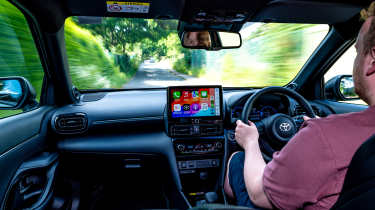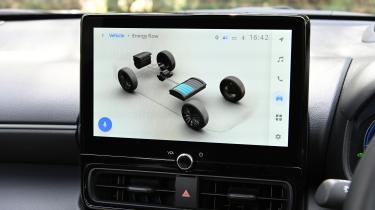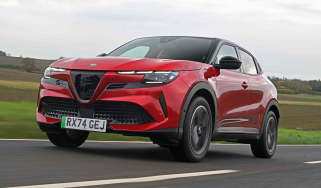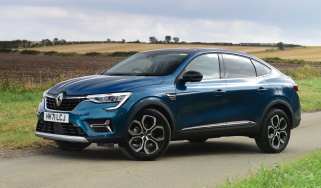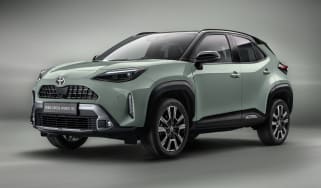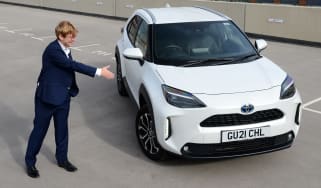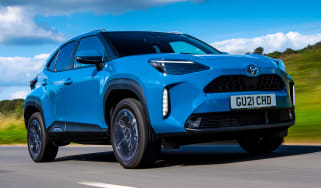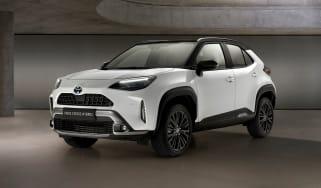Toyota Yaris Cross review
The Toyota Yaris Cross is a sensible, efficient, and appealing small SUV

Is the Toyota Yaris Cross a good car?
The Toyota Yaris Cross delivers where it matters most for buyers considering a small SUV. Of course, there’s the benefit of the higher driving position with better visibility, and slightly more practicality than the Yaris supermini upon which it is based, but the Yaris Cross is also competitively priced compared to its rivals, is easy to pilot around town and offers excellent real-world economy courtesy of its efficient hybrid system.
Yes, it feels like Toyota’s bean counters have had the last word in certain areas of the cabin, and some of its rivals are better for rear space. However, it’s a good-looking little car offering a generous level of standard kit and a recent round of updates has brought benefits up and down the range, including bigger touchscreens. Plus buyers on a budget needn’t worry because overall running costs should be pretty low.
Our choice: Toyota Yaris Cross Hybrid Design
| Key specs | |
| Fuel type | Petrol hybrid |
| Body style | Small SUV |
| Powertrain | 1.5-litre 3cyl petrol plus 1x e-motor, front-wheel drive 1.5-litre 3cyl petrol plus 2x e-motor, four-wheel drive |
| Safety | 5-star Euro NCAP (2021) |
| Warranty | 3yrs/60k miles (up to 10yrs/100k miles with routine franchised dealer servicing) |
Toyota Yaris Cross: model range, specs and rivals
The Toyota Yaris Cross is the Japanese brand’s entry into the jam-packed small SUV segment, and starts from £26,000 in entry-level Icon trim. Our preferred Design trim costs around £29,000.
As the name suggests, it’s based on the regular Toyota Yaris and uses the same 'self-charging hybrid' technology as the frugal little supermini, which is at its best when driving in and around town, on shorter, urban commutes or competing in the hustle and bustle typical of the daily school run.
Used - available now

2025 Toyota
Yaris Cross
23,928 milesAutomaticPetrol1.5L
Cash £19,999
2025 Toyota
Yaris Cross
7,001 milesAutomaticPetrol1.5L
Cash £20,815
2024 Toyota
Yaris Cross
29,032 milesAutomaticPetrol1.5L
Cash £22,039
2025 Toyota
Yaris Cross
50,258 milesAutomaticPetrol1.5L
Cash £17,737Since its introduction three years ago, the Yaris Cross has been a smash hit across Europe – even by small SUV standards, which generally fly out of showrooms faster than Marvel releases new superhero movies. More than 180,000 examples were sold in 2023 alone, nearly 20,000 of which found homes in the UK.
Toyota clearly didn’t want to mess with that success when upgrading the Yaris Cross for 2024, because rather than a wholesale facelift, the brand focused on a few carefully selected improvements. This is a bold move, especially considering many key rivals have recently received significant overhauls.
There are some all-electric alternatives too, but not everyone can install a wallbox charger or have public chargers nearby where they live. This is why a full-hybrid is a fine middle ground between pure-petrol and EVs. Such a system can drive the car for short distances using electric power alone, but it doesn’t get electricity from a plug socket. Instead, energy is recuperated during braking, or when the engine doesn’t need to provide all its power to the wheels to drive the car. The end result is a smooth driving experience in town, and impressive fuel economy.
Every Yaris Cross features a 1.5-litre three-cylinder petrol engine under the bonnet, plus an electric motor to drive the front wheels. Most models offer a combined output of 114bhp and 141Nm of torque, however, top-spec cars now boast a more powerful setup with 129bhp and 185Nm on tap.
A CVT automatic transmission is standard throughout the range, with no manual gearbox available. However, buyers can upgrade to all-wheel drive, or ‘AWD-i’ as Toyota calls it, which adds another small e-motor to the rear axle for extra traction in slippery conditions.
The entry-level Icon trim provides a decent level of kit, including 16-inch alloy wheels, a nine-inch touchscreen, wireless Apple CarPlay and Android Auto connectivity, a seven-inch instrument panel, adaptive cruise control, reversing camera and automatic air conditioning. Design, Excel, GR Sport and Premiere Edition specifications make up the rest of the range, and add features such as a 10.5-inch central display, 12.3-inch digital driver’s display, a wireless charging pad, a hands-free electric tailgate and larger alloy wheels.
How much does the Toyota Yaris Cross cost?
Toyota Yaris Cross prices start from £26,155 and go up to £33,125. The Auto Express network of trusted dealers is currently offering discounts on those recommended retail prices of up to £2,558 via our Find a Car service. Alternatively, you can lease a Toyota Yaris Cross from around £257 per month.
Engines, performance & drive
With a focus on efficiency rather than outright performance, the Toyota Yaris Cross doesn’t offer too much in the way of sprinting ability. Acceleration times are average at best, and the combination of a 1.5-litre three-cylinder petrol engine, a small electric motor, and a CVT automatic transmission won’t excite keen drivers in the same way a manual Ford Puma would. If you push on a bit, the petrol engine in the Yaris Cross provides a typical three-cylinder thrum, which some might think sounds a little more interesting than a droning four-cylinder.
| Model | Power | 0-62mph | Top speed |
| Yaris Cross 1.5 Hybrid | 114bhp | 11.2 seconds | 106mph |
| Yaris Cross 1.5 Hybrid AWD | 114bhp | 11.8 seconds | 106mph |
| Yaris Cross 1.5 Hybrid 130 | 128bhp | 10.7 seconds | 106mph |
| Yaris Cross 1.5 Hybrid 130 AWD | 128bhp | 11.3 seconds | 106mph |
What is the Toyota Yaris Cross like to drive?
In town
Toyota has identified that Yaris Cross buyers will most probably live in more built-up, urban areas, so it’s important that the small SUV is comfortable and easy to pilot around town. Has it succeeded? For the most part, yes. The Yaris Cross can run on smooth electric power up to 30mph – provided you’re very gentle with the accelerator. When the petrol engine has to kick in, the switchover is barely noticeable as it kicks in to assist in increasing the pace. It’s a good set-up for driving in stop-start traffic for those after an automatic, feeling much less jerky than an auto Citroen C3 Aircross, Peugeot 2008, and Vauxhall Mokka. During our long-term testing of a Yaris Cross, we found the hybrid system did a great job of utilising battery power as much as possible in stop/start traffic.
On A- and B-roads
Around bends, the Yaris Cross is a surprisingly composed and fun little car to chuck around, though ultimately, it isn’t as nimble as the aforementioned Puma. Similarly, while ride comfort is reasonably good at slower speeds, the car is a little bit fidgety on faster roads, and it certainly can’t match the plush ride of the Hyundai Kona.
The GR Sport trim promises sharper steering than other versions and features tweaked suspension to make the Yaris Cross a bit more fun. However, we found the stiffer set-up gives it a fidgety ride at low speeds like a Nissan Juke, and feels a little more harsh over rougher surfaces at speed. The GR Sport does keep body lean in check better than the standard version, but the trade-off isn’t good enough to warrant the further reduction in ride quality.
On the motorway
Toyota has made several changes to improve refinement in the Yaris Cross, including thicker glass for the windscreen and all the side windows. These have helped reduce wind noise, but road and tyre noise are still noticeable at higher speeds.
0-62mph acceleration and top speed
Most versions of the Toyota Yaris Cross use a ‘self-charging’ hybrid system producing 114bhp and 141Nm of torque, giving it a 0-62mph time of 11.2 seconds for the front-wheel drive version, while the extra weight of the all-wheel drive version increases this acceleration time to 11.8 seconds.
Top-spec GR Sport and Premiere Edition cars boast a more powerful setup with 129bhp and 185Nm, which trims the 0-62mph time down to 10.7 seconds, or 11.3 seconds if you want all-wheel drive. The extra power comes from an uprated e-motor, which makes a noticeable difference around town, feeling quicker away from the lights. We also noticed the petrol engine didn’t seem to chime in as often, helping improve fuel economy. When the engine does kick in, it sounds a little strained when you put your foot down to join the motorway or overtake, though once you ease off, everything settles down.
MPG, emissions & running costs
Low running costs are a particularly strong area for the Toyota Yaris Cross. Along with being relatively cheap to insure and maintaining decent residual values, the petrol-hybrid set-up means that you’ll benefit from superb economy figures and low CO2 emissions.
The Japanese giant claims that the Yaris Cross should return over and above the near 50mpg you’ll typically get from a Ford Puma, with the Toyota hybrid system averaging between 54-64mpg, depending on your chosen specification, and whether you’ve opted for front- or all-wheel drive. We lived with a FWD Yaris Cross in Design trim for several months, during which time it returned an average of 64.7mpg, though it indicated much higher figures on several occasions, so Toyota’s numbers certainly seem to stack up in real-world driving. During our time with the Yaris Cross we spent a lot of time driving on the electric motor alone, without any intervention from us telling the car when to switch from electric to petrol power.
| Model | MPG | CO2 | Insurance group |
| Yaris Cross 1.5 Hybrid | 62.8mpg | 107g/km | 11E |
| Yaris Cross 1.5 Hybrid AWD | 55.4mpg | 115g/km | 12E |
| Yaris Cross 1.5 Hybrid 130 | 58.9mpg | 109g/km | 14E |
| Yaris Cross 1.5 Hybrid 130 AWD | 55.4mpg | 115g/km | 14E |
Tax
For company car drivers who aren’t considering a plug-in hybrid or electric car just yet, the entry-level Toyota Yaris Cross Icon model has reasonably low CO2 emissions of 100g/km, which attracts a Benefit-in-Kind tax rate of 26 per cent. Upgrade to the AWD versions and the BiK rate climbs to 28 per cent.
Insurance
You shouldn’t need to splash out on insurance cover for the Toyota Yaris Cross. The entry-level Icon model is in group 11 (on the 1 to 50 scale), while all other versions sit in group 12. The more powerful 128bhp versions are in group 14.
In comparison, a 123bhp Ford Puma in ST-Line trim sits in group 12, while the petrol Hyundai Kona with 118bhp will be slightly more expensive to insure because it starts in group 16.
Depreciation
The Toyota Yaris Cross range offers a sliding scale in terms of residual values, with the cheaper Icon model performing the best. After a typical three-year/36,000-mile ownership period, our latest expert data suggests that an Icon model will hold onto around 54 per cent of their original list price, while a top-of-the-range 1.5 Hybrid 130 Premier Edition AWD will see this figure fall to 48 per cent.
For comparison, the Yaris Cross performs just as well as the Ford Puma and Volkswagen T-Cross in terms of residual value over the same period.
To get an accurate valuation for a specific model, check out our free car valuation tool...
Interior, design & technology
The Toyota Yaris Cross sits on the same TNGA-B platform as the latest Yaris supermini, but being a small SUV it rides higher, has greater ground clearance, and a more rugged look. The black plastic cladding around the wheel arches adds a little extra flavour to its chunky, cross-country credentials, while stylish aluminium roof rails are standard on all but the entry Icon model. You can also specify a black roof in combination with certain body colours to add a little extra personalisation.
What is the Toyota Yaris Cross like inside?
The cabin of the Yaris Cross is best described as functional because it isn’t particularly exciting.
As part of the updates for 2024, entry-level models now feature a nine-inch touchscreen, plus wireless Apple CarPlay and Android Auto connectivity. The rest of the range comes with an even larger 10.5-inch display, running Toyota’s latest ‘Smart Connect’ infotainment system – we’ll talk more about that in the section below.
Behind the steering wheel, Icon and Design trim cars get a seven-inch digital instrument panel, while higher grades benefit from a 12.3-inch display with various layouts and themes available. They’re a definite improvement, particularly in terms of clarity, over the analogue dials the Yaris Cross used to have.
If you’re after luxuries such as heated front seats and steering wheel, head-up display, JBL sound system, you’ll need to look towards the Excel, GR Sport or Premiere Edition trim levels. That’s not to say the Icon and Design specifications are poorly equipped; each includes alloy wheels, keyless entry, adaptive cruise control, and a reversing camera.
As the name suggests, the GR Sport version gives the Yaris Cross a slightly more athletic look, but don’t be fooled into thinking it’s any faster or could be Toyota's answer to the Ford Puma ST – it’s mainly just a few styling changes and some suspension tweaks.
What is the interior quality like?
Some of the plastics inside the Yaris Cross can be a little hard and scratchy, but it does generally feel well-built and uses physical climate controls and simple switchgear that feel nicely damped.
Sat-nav, stereo and infotainment
Base models have a nine-inch touchscreen with the Toyota Touch 2 infotainment system, which is relatively simple to navigate, and features wireless Apple CarPlay and Android Auto connectivity. This setup also has some shortcut buttons around the screen, which are handy while driving.
Go for Design trim and above, and the Yaris Cross features a 10.5-inch touchscreen, running Toyota’s latest ‘Smart Connect’ user interface system – the same one found in the Toyota bZ4X and Toyota C-HR. Compared to the other system, it’s sharper, quicker to respond and the menus are easier to navigate, though we still didn’t find it to be quite as intuitive or snappy as the Google-powered tech in the refreshed Renault Captur.
Boot space, comfort & practicality
The Toyota Yaris Cross is taller and rides higher than the Toyota Yaris hybrid supermini it shares its underpinnings with, giving the raised driving position many drivers like. It’s a five-seat small SUV, although three across the back seat will be a squeeze and there isn’t a great deal of rear leg room for those travelling in the second row.
Slightly unusually, seatback pockets and underfloor boot storage are only standard on Excel trim and above, and if you want cupholders in the back, you have to upgrade to the Design trim level.
| Dimensions | |
| Length | 4,172mm |
| Width | 1,765mm |
| Height | 1,595mm |
| Number of seats | 5 |
| Boot space | 460-1097-litres (401-1097-litres AWD) |
Dimensions and size
At 4,180mm long, the Toyota Yaris Cross is 240mm longer than its supermini sibling, but the 2,560mm wheelbase is the same for both. They’re similar widths, too, with the Yaris Cross measuring 1,765mm wide, but the compact SUV stands 1,595mm tall – 95mm taller than the regular Yaris.
To get a sense of how the Yaris Cross sizes up compared to its close rivals, the Ford Puma is a little longer and wider, although it has a lower roofline, while the Renault Captur is the longest of the three and sits between the Yaris Cross and Puma in terms of overall width and height.
How practical is the Toyota Yaris Cross?
Seats & space in the front
The front seats in the Toyota Yaris Cross offer good support, while standard kit such as a central armrest, a reach and rake-adjustable steering wheel and front cup holders help to make things more comfortable. Step up to mid-range Design trim, and you get electrically adjustable lumbar support – a rarity in this class.
Storage could be better, with the Cross featuring a relatively small boot and little space to keep odds and ends secure in the cabin. The fabric parcel shelf looks cheap, and adds to the feeling that Toyota approached its small SUV with cost-savings firmly in mind.
Seats & space in the back
The rear bench in the Yaris Cross offers enough headroom for anyone around six foot tall, but legroom is in relatively short supply, so taller teenagers and adults probably won’t want to spend much time in the back of the Yaris Cross. They’ll also be disappointed by the lack of any USB charging ports, and access is compromised due to the small rear doors.
There are two sets of ISOFIX child seat mounting points in the back of the Yaris Cross, however, the small door openings and limited space will make it difficult to accommodate bulky child seats.
Boot space
The front-wheel drive Toyota Yaris Cross provides 397 litres of luggage space up to the tonneau cover versus the all-wheel drive version’s 320 litres. Fold the rear seats down, and the load volume expands to 1,097 litres. It’s worth noting that entry-level Icon cars get a 60:40 split-folding rear bench, while all others get seats that split 40:20:40.
More expensive models (Excel and above) include a false boot floor that can create a flush load area with the load lip and folded back seats. That’s pretty handy because the Yaris Cross has a hefty lip to try and get heavier items over. It’s a shame you can’t add this as a reasonably priced option on other trims, because an adjustable height boot floor is something that’s standard on the Volkswagen T-Cross.
Rivals have the Yaris Cross beat in this area, with the Ford Puma offering 456 litres of boot space, while the Dacia Duster boasts a 517 litres. The Renault Captur also provides 422 litres as standard, but the ace up its sleeve is its sliding rear bench, meaning you can push capacity to 536 litres when needed.
Towing
Towing capacity is nothing to write home about because no version can lug around more than a 750kg braked trailer, making the 13-pin tow bar option a bit pointless. A Kona Hybrid can haul up to 1,300kg, while dedicated caravan types must go for the four-wheel drive ‘4Motion’ VW T-Roc. That can tow up to 1700kg in both 2.0-litre petrol and diesel forms.
Reliability & safety
Safety experts Euro NCAP awarded the Toyota Yaris Cross its maximum five-star crash safety rating in 2021, with scores of 86 per cent and 84 per cent for adult and child occupant protection, respectively. It also achieved an 81 per cent result for its onboard Safety Assist technology and 78 per cent for protecting vulnerable road users. For comparison, the Ford Puma only managed to achieve a four-star rating, with a 75 per cent rating for adult occupant protection and just 69 per cent in the Safety Assist category.
The standard equipment includes a raft of active systems, such as adaptive cruise control to keep you a safe distance from the car in front, plus there’s a lane-keeping assist system to help you stay within your lane on the motorway. There’s also road sign assist, which reads the speed limit from road signs, and an autonomous emergency braking (AEB) system to mitigate or prevent collisions with other vehicles and vulnerable road users at low speeds around town.
For 2024, the active safety suite has been enhanced with systems like Acceleration Suppression at low speeds and Emergency Driving Stop. There’s also a camera and radar system that can scan wider and further ahead, improving the detection of potential hazards and, according to Toyota, allows the Pre-Collision System to recognise risks earlier for possible head-on impacts with other vehicles crossing your path, pedestrians, cyclists, and motorcycles.
The Yaris Cross didn’t make it onto our best cars to own list based on the 2024 Driver Power owner satisfaction survey results, but the Toyota Yaris hybrid supermini on which it's based managed to finish in 3rd place overall out of 50 cars. Four Toyota vehicles made it onto our best cars to own list, which we reckon the brand will be pretty pleased with.
| Key standard safety features | Euro NCAP safety ratings |
|
Warranty
Toyota provides a standard three-year/60,000-mile warranty for the Yaris Cross. After this period expires, you can receive a further 12 months cover every time you have your vehicle serviced at an official dealer – up to a maximum of 10 years or 100,000 miles, whichever comes first.
Servicing
Just like the Yaris supermini, the Toyota Yaris Cross needs servicing once a year or every 10,000 miles, whichever comes first. Toyota offers its Service Plan Plus for the Yaris Cross, which includes three scheduled services, one MOT and an extra two years of roadside assistance on top of the one year every new Toyota gets. It's a three-year plan, and will cost you £28 per month.
Toyota Yaris Cross alternatives
The Toyota Yaris Cross will appeal to those who only occasionally need to put people in the back, and want a car that’s cheap to run in terms of fuel costs, insurance and depreciation. They’ll also value strong equipment levels with plenty of safety assistance technology. The Yaris Cross is a rarity in the small SUV class that can be had with four-wheel drive, which might be very useful to those who need the additional traction of four-wheel drive in slippery conditions.
It isn’t the most practical small SUV and misses out on some useful practicality features of its rivals, such as the sliding rear seats of a Renault Captur and Volkswagen T-Cross, which allow you to trade boot space for rear leg room if you have taller passengers, or the Megabox in the boot of the Ford Puma for some hidden underfloor storage. The Puma is also much nicer to drive than the Yaris Cross, with greater driver engagement.
There are also established rivals such as the Nissan Juke to consider, or the more premium-feeling Peugeot 2008. The latter can be had with a range of petrol, hybrid, or all-electric powertrains, just like the Hyundai Kona, Kia Niro, and Jeep Avenger.
Toyota Yaris Cross Design: long-term test
Back in 2022, our then news and reviews editor, James Brodie, enjoyed six months of highly economical motoring in a mid-range Toyota Yaris Cross Design. It did everything expected of it and didn’t throw up any surprises in several thousand miles of motoring.
That being said, James didn’t find it to be the most interesting of small SUVs out there, and he wasn’t all that impressed with rear seat accommodation, which could, he thought, be a bit of a problem for families.
Frequently Asked Questions
The Toyota Yaris Cross looks the part, is easy to pilot around town and offers excellent real-world fuel economy courtesy of its efficient hybrid system.

